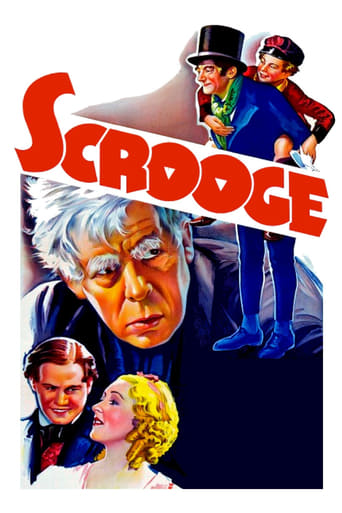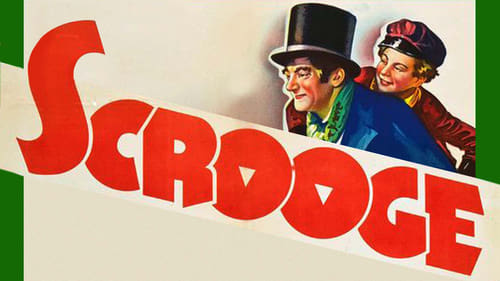JohnHowardReid
The players (in credits order): Sir Seymour Hicks (Scrooge, a miser), Donald Calthrop (Cratchit, his clerk), Robert Cochran (Fred, his nephew), Mary Glynne (Belle), Oscar Asche (Christmas Present), Athene Seyler (Scrooge's housekeeper), Mary Lawson (poor man's wife), Maurice Evans (poor man), Garry Marsh (Belle's husband), Barbara Everest (Mrs Cratchit), Eve Grey (Fred's wife), C.V. France (Christmas Future), Morris Harvey (the poulterer), Philip Frost (Tiny Tim), D.J. Williams (the undertaker), Margaret Yarde (Scrooge's laundress), Hugh E. Wright (Old Joe), Charles Carson (Middlemark), Hubert Harben (Worthington).The technicians (transposed from the opening credits of the movie): Director: HENRY EDWARDS. Screenplay adaptation: H. Fowler Mear. Dialogue: Charles Dickens. Based on the 1843 novelette, A Christmas Carol, by Charles Dickens. Photography: Sydney Blythe, William Luff. Supervising film editor: Jack Harris. Film editor: Ralph Kemplen. Art director: James A. Carter. Music scored and directed by W.L. Trytel. Costumes: L. & H. Nathan. Hair styles: Charles. Producer supervisor: Hans Brahm. Assistant directors: Arthur Barnes, James Davidson. Sound recording: Baynham Honri. Visatone Sound System. Producer: Julius Hagen.Produced at Twickenham Film Studios. Copyright 30 December 1935 by Paramount. U.S. release through Paramount: 30 November 1935. New York opening at Loew's Orpheum: 13 December 1935. U.K. release through Twickenham: August 1935. Australian release through 20th Century-Fox: 1 January 1936. 78 minutes. COMMENT: Seymour Hicks was a Scrooge specialist. He'd played the role over two thousand times on the stage before making his initial film version in 1913 (for which he himself wrote the scenario). He'd no need to write the script for this one which follows Dickens so faithfully it even uses the novelist's own dialogue. To put it simply, Hicks is Scrooge to the letter. The other characters are likewise faithful transitions, and all are superbly brought to life here.
Produced on an admirably lavish budget, the movie is brilliantly directed by Henry Edwards who imaginatively takes full advantage of the many prodigiously decorated sets. The music score is also a stand-out. In all, this is a truly moving yet spirited production that cannot be faulted even by the most fervent Dickensian. Those who dote on special effects, however, will have a beef. There are very few-and I think the movie is all the better for this restraint. For once, we don't have Marley's ghost visualized before our eyes-aside from his obligatory imposition on the door knocker. Instead we hear his voice and the ominous rattling of his chains. A few present-day critics have complained that Oscar Asche is far from their conception of Christmas Present-yet his appearance and his "business" are based on an extremely popular illustration widely circulated both in the book itself and as a Christmas card in the first half of the 20th century. To depict Christmas Present otherwise would have keenly disappointed most picturegoers. In fact, Oscar Asche was so admired in the part that his name not only became a household word but was widely used as a rhyming-slang synonym for "cash". I've lost count of the number of times I've been accosted in the street by friends, beggars and strangers who asked, "Got any Oscar Asche, mate? Any Oscar Asche?"
Christmas-Reviewer
BEWARE OF FALSE REVIEWS & REVIEWERS. SOME REVIEWERS HAVE ONLY ONE REVIEW TO THEIR NAME. NOW WHEN ITS A POSITIVE REVIEW THAT TELLS ME THEY WERE INVOLVED WITH THE MOVIE. IF ITS A NEGATIVE REVIEW THEN THEY MIGHT HAVE A GRUDGE AGAINST THE FILM . NOW I HAVE REVIEWED OVER 200 HOLIDAY FILMS. I HAVE NO AGENDA. I AM HONESTThis adaption of the novel would make Charles Dickens happy. In case you don't the story here it is.Scrooge is a mean old man. He is always unhappy "about everything". He thinks his employee getting a day off work for Christmas really sets him off. He reluctantly does. On Christmas Eve 4 Ghost come to visit him and shows him how his anger has hurt "Only Himself" Now I like this adaption. According to IMDb there is 2 editions of the film. One runs an hour. The other one runs 78. I have yet to see the longer one. This film is also in public domain. And unfortunately many DVD versions of this film. Anybody can release or show this for free. That's too bad. Because it needs to be restored. Nobody restores public domain films.
frankdfleming
Scrooge (the 1935 version) is marked by good story-telling, a comfortable pace and workmanlike acting performances. Considering the 1935 production date, the cinematography and special effects are commendable.I enjoyed that it included scenes that typically aren't part of other productions. For example, there is a scene involving an extravagant banquet where scraps are literally thrown out the window to the poor gathered outside the kitchen preparation area. Additionally, you'll see Tim lying dead upon his bed which likely was a surprise and shock to audiences of the day.There were some disappointments as well including Marley's ghost and Bob Cratchit. Although Scrooge can both see and hear Marley's ghost, the viewer can only hear the ghost (who according to the cast list is The Invisible Man, Claude Rains himself in an uncredited role). The meeting between Scrooge and Marley is often one of the story's most powerful scenes and not letting the audience actually see Marley was a mistake. As for the actor playing Bob Cratchit, he seemed a bit too old for the part and failed to generate the sympathy so strongly felt for the character in other presentations.Overall though, for those who love the story, this is a presentation that you can enjoy.
Phenominal67
Being a big fan of the classic Dickens story, I have decided to watch all the movie and cartoon versions and share my views of them here starting with the first motion picture talkie version, this 1935 British movie starring Sir Seymour Hicks.Lets start out with the negatives of this production, starting with what's missing from Dicken's story. Much from the Christmas past chapter is missing and I find it to be the most important of Scrooge's visits from the spirits. There is no trip to Eb's old school and his love for discovering the classics, no Sister Fan's visit to take him home, and more importantly, no Fezziwig. Without the old Fezziwig party scene, we lose Scrooge remembering what it was like to feel joy again and how well his old boss treated him as opposed to how he treats his man Cratchit. Two points that make Scrooge's transformation much more believable.Christmas past does include the scene where the love of his life, Belle, lets him go, however this scene comes off as laughable. Instead of having a younger actor portray young Ebenezer, they put a dark haired wig on Hicks and have an older woman portray Belle. The acting in this scene is too over the top and the music is overbearing and silly.A big letdown in this version are the ghosts. Christmas present is the only one of them visible and his entrance contains the spirit devouring a turkey leg while speaking his lines. He's like a Shakespearian General Bulkhalter from "Hogan's Heroes". And although we do see Jacob Marley's face on the door knocker, for some reason he's invisible in Scrooge's chambers.One of the best points of the movie is in just about every scene included from the book, the dialog is very faithful. The only scene really where it is not is the Marley scene where they cut about a page of text. They take out the part where Marley puts the scare of Scrooge by moaning and rattling his chains until Scrooge believes in him. I think it is very important to the story.I also like very much the Cratchits in this one. Bob and his wife may be a bit older than they should be, but I think they play the parts well of a tattered and torn family just getting by and not letting their circumstances break their spirits.As for Scrooge himself, Seymour Hicks's acting overall is good. But I think he makes just an OK Scrooge. There's something about him- A bit Sterling Hollawayish that makes him a peculiar choice for the part.All in all, I barely gave it a 7. Points earned for close Dicken's text, Hick's acting, and for the Cratchits. On the minus side, a few points taken away for Marley's ghost and Christmas past.




